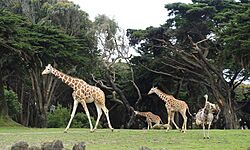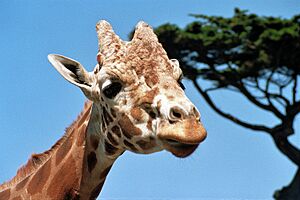San Francisco Zoo facts for kids
 |
|

African Savannah
|
|
| Location | San Francisco, California |
|---|---|
| Land area | 100 acres (40 ha) |
| Coordinates | 37°43′59″N 122°30′11″W / 37.73306°N 122.50306°W |
| No. of animals | 1000+ (2015) |
| No. of species | 250+ (2015) |
| Memberships | AZA |
| Major exhibits | African Savanna, Gorilla Preserve, Grizzly Gulch, Primate Discovery Center (Lemur Forest), Cat Kingdom, Penguin Island, Red Panda Treehouse, Insect Zoo |
The San Francisco Zoo and Gardens is a fun place to visit in San Francisco, California. It covers 100 acres and is located near Lake Merced and the Pacific Ocean. The zoo is owned by the city's Parks Department. It is managed by a non-profit group called the San Francisco Zoological Society.
As of 2016, the zoo was home to over 1,000 animals. These animals represent more than 250 different species. The zoo is famous for being the birthplace of Koko the gorilla. It was also home to Elly, the oldest black rhinoceros in North America, until 2016. In April 2025, the San Francisco Zoo was ranked as the 6th best zoo in the United States!
Contents
The Zoo's Story
The zoo was first called the Fleishhacker Zoo. It was named after Herbert Fleishhacker, who helped start it. He was a banker and president of the San Francisco Parks Commission. Planning for the zoo began in 1929. It was built next to the huge Fleishhacker Pool. This area already had a children's zoo and a playground. There was also a classic carousel from 1921 and a special building for mothers and children. Many animals came from Golden Gate Park to live at the new zoo. These included zebras, a cape buffalo, monkeys, and three elephants.
Early Animal Homes
In the 1930s, the first animal exhibits were built. These cost $3.5 million. They included Monkey Island, the Lion House, and the Elephant House. There were also homes for small mammals, an aviary for birds, and bear grottos. These animal homes were very open and didn't use bars. They were some of the first of their kind in the country.
Helping the Zoo Grow
In 1955, a newspaper started a fundraiser called "The News Elephant Fund." Children from all over the country sent in their pennies. Even famous TV host Ed Sullivan helped out. They bought a baby female Asian elephant named Pennie. She was named Pennie because she was bought with pennies! Pennie lived at the zoo until 1995.
The Zoological Society became very important for raising money. They helped the zoo get rare animals and improve its operations. The Society quickly grew to have over 1,300 members. Today, it has nearly 25,000 members! They funded many projects, like fixing up the Children's Zoo in 1964. They also helped create the African Scene in 1967. The Society bought medical equipment for the zoo hospital in 1975. They also helped start the Avian Conservation Center in 1978.
Elephant Care and Relocation
In November 2004, Tinkerbelle, the zoo's last Asian elephant, moved to a special sanctuary. This sanctuary is run by the Performing Animal Welfare Society (PAWS). It is located in the Sierra Nevada mountains. In March 2005, Lulu, the zoo's last African elephant, also moved there. Sadly, Tinkerbelle passed away just one month after Lulu arrived. Lulu lived at the sanctuary until April 2024. She was 58 years old and the oldest African elephant in captivity in the country. These moves happened after two other elephants, Calle and Maybelle, passed away in 2004.
New Arrivals and Special Guests
In early 2006, the zoo offered to name a baby American bald eagle after comedian Stephen Colbert. This brought a lot of good attention to the zoo. The eagle, named Stephen Jr., was born on April 17, 2006.
In April 2024, the mayor of San Francisco, London Breed, announced exciting news. The San Francisco Zoo will welcome giant pandas from China! This is a big step for the zoo.
Exhibit Upgrades and New Homes
The San Francisco Zoo has worked hard to improve its animal homes. Many exhibits have been renovated or built new over the years. Here are some of the changes:
- Otter River (1994) for North American river otters.
- Feline Conservation Center (1994) for small cats like snow leopards.
- Australian WalkAbout (1995) for red kangaroos and emus.
- Kodiak Bear Exhibit (1996) for large bears.
- Aye-aye Forest (1997) for unique lemurs.
- Lorikeet Landing (1998) where you can see colorful lorikeets.
- Puente al Sur (1999) now home to giant anteaters and capybara.
- South American Tropical Forest Aviary (2000) with birds, caiman, and an anaconda.
- Lipman Family Lemur Forest (2002) for five types of Madagascan lemurs.
- African Savanna (2004) where giraffes, zebras, and ostriches roam together.
- Hearst Grizzly Gulch (2007) for Grizzly bears.
- Mexican Wolf Canyon (2016) for Mexican wolves.
- Expanded Snow Leopard Habitat (2022) giving these big cats more space.
Animals and Exhibits
The San Francisco Zoo is home to many amazing animals from all over the world. They are grouped into different regions and exhibits.
African Region
Leanne B. Roberts African Savanna
This large area lets you see animals that live on the African plains.
African Aviary
This bird house is filled with African birds.
Jones Family Gorilla Preserve
Doelger Primate Discovery Center
This center is all about primates and other interesting creatures.
- Coquerel's sifaka
- Dumeril's boa
- Fossa
- François' langur
- Mandrill
- Spider tortoise
Lipman Family Lemur Forest
This outdoor forest is a special home for lemurs from Madagascar.
- Black-and-white ruffed lemur
- Crowned lemur
- Red-bellied lemur
- Red-fronted lemur
- Red ruffed lemur
- Ring-tailed lemur
Great Ape Passage
Cat Kingdom
This area features big cats and other large animals.
- Black rhinoceros
- Bongo
- Blue-throated macaw
- Eastern box turtle
- Galápagos tortoise
- Indian rhinoceros
- Jaguar
- Komodo dragon
- Lion
- Ocelot
- Snow leopard
- Southern pudu
- Wolverine
Penguin Island
Outback Trail
Explore animals from Australia!
South America
Puente al Sur
This exhibit features animals from South America.
South American Tropical Rainforest and Aviary
Step into a rainforest filled with birds, reptiles, and amphibians.
- Amazon tree boa
- American white ibis
- Blue-headed macaw
- Blue-throated piping guan
- Blue-winged teal
- Boa constrictor
- Crested oropendola
- Curl-crested aracari
- Dyeing poison dart frog
- Emerald tree boa
- Golfodulcean poison frog
- Green and black poison dart frog
- Honduran spiny-tailed iguana
- Linnaeus's two-toed sloth
- Northern caiman lizard
- Panamanian golden frog
- Red-eyed tree frog
- Red-footed tortoise
- Red-lored amazon
- Roseate spoonbill
- Ruddy duck
- Scarlet ibis
- Smoky jungle frog
Bear Country
See different types of bears and other animals.
Exploration Zone
This zone has a variety of interesting creatures.
Conservation Efforts
The San Francisco Zoo is dedicated to helping animals. They rescue animals and participate in important conservation programs.
Two black bears were rescued as orphans in Alaska in 2017. They were found without their mothers. The Alaska Department of Fish and Game determined they needed help. They were brought to the Alaska Zoo and got healthy again. The San Francisco Zoo then gave them a new home in 2017.
Henry, a 10-year-old blind California sea lion, was found on a beach in Humboldt County in 2010. In 2012, he came to the San Francisco Zoo. Here, he received special care for his blindness.
Species Survival Projects
The San Francisco Zoo takes part in Species Survival Plans (SSPs). These are conservation programs from the Association of Zoos and Aquariums. SSPs started in 1981 to help breed certain animal species. The goal is to keep animal populations healthy and diverse. The zoo is involved in over 30 SSP programs. They work to protect many species, from Madagascan radiated tortoises to black rhinos and gorillas.
See also
 In Spanish: Zoológico de San Francisco para niños
In Spanish: Zoológico de San Francisco para niños
- Citizens Lobbying for Animals in Zoos



